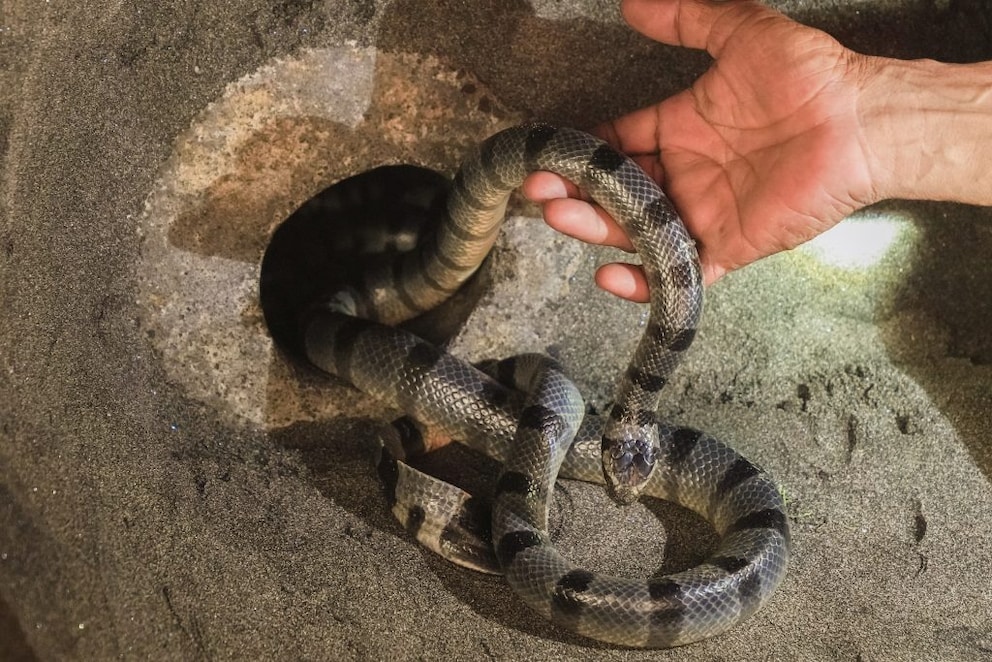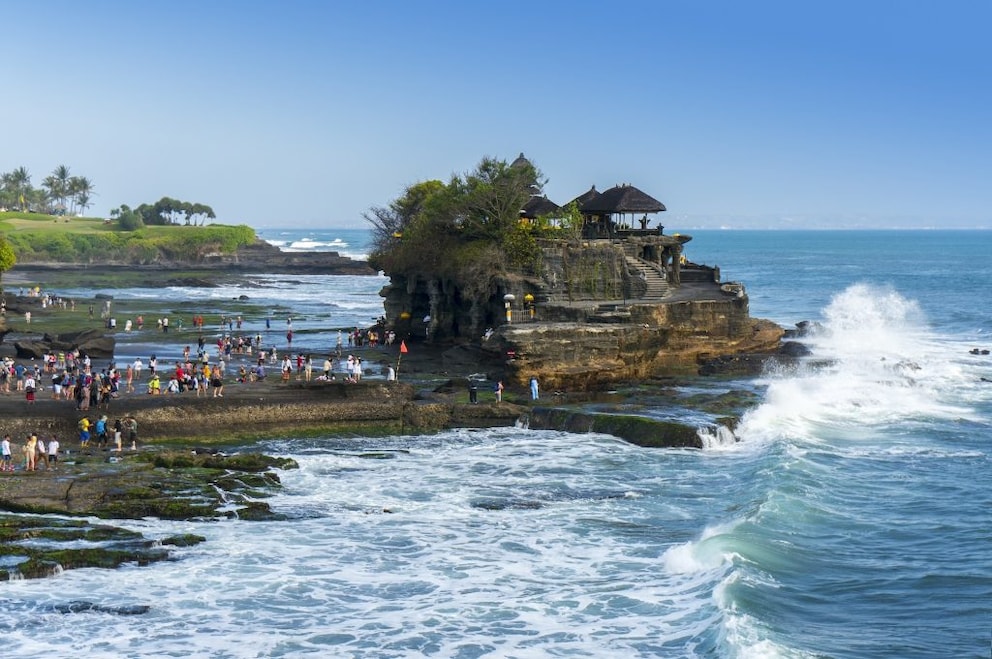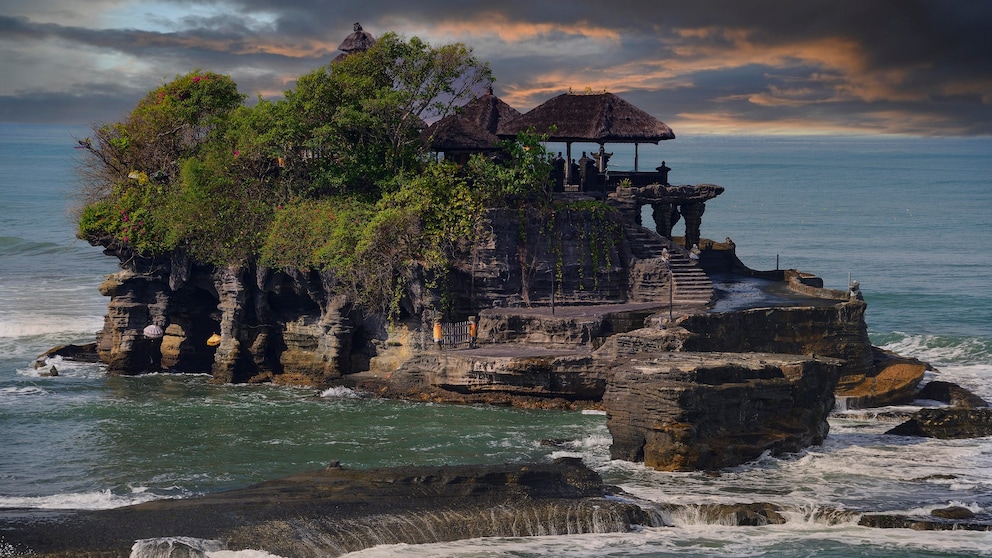February 21, 2025, 4:03 pm | Read time: 8 minutes
The impressive Tanah Lot temple sits enthroned on a rock off the coast of Bali. It is one of seven sacred shrines in the sea around the island and has become a particular tourist magnet. This is probably due to the legend surrounding the holy site. It has a very real background that is likely to send a shiver down the spine of many visitors. On a recent trip, our author visited the temple for you.
When my girlfriend recently proposed we ring in the new year in Bali instead, I was immediately thrilled for a multitude of reasons. 30 degrees and island fever instead of Berlin, which is usually permanently gray at this time of year. Fresh fish and exotic fruit juice every day. Fantastic beaches, deep green jungle and, last but not least, venerable, centuries-old temples. There are countless of them in Bali, which is predominantly Hindu. However, I was particularly interested in one very special one: a sacred place called Tanah Lot on a rock in the sea. And as chance or fate would have it, this temple was located not far from Canggu, our first stop on the trip.
Overview
Tanah Lot has fascinated me ever since I first wrote about it in TRAVELBOOK a few years ago. A temple revered by Hindus that could just as easily appear as a credible backdrop in an Indiana Jones film. Having actually been there in January 2025, I can say that the sight in real life is even more amazing and astonishing than in the numerous pictures of Tanah Lot that circulate on the internet. And then there is the legend of a holy man who is said to have built the temple. And it has to do with snakes. With very, very poisonous snakes. And it is precisely these animals that “guard” the shrine to this day.
Funfair Instead of Contemplation
Let’s start at the beginning. Just a few days after our arrival, I made my way to the Tanah Lot temple with my girlfriend. Depending on how congested the roads are, it takes between 25 and 40 minutes to get there by cab or scooter. The former can be ordered in any major Balinese city thanks to the “Grab” or “Gojek” apps. It sometimes takes less than a minute for the drivers to arrive, and, at least in Canggu, everyone seems to work for one of the two services. Another advantage is that the cab drivers often offer themselves as private chauffeurs during the journey, which you can book very cheaply, even by the day.
Upon arrival, though, we were met with quite the surprise. Instead of a quiet place with a devout, holy atmosphere, we were greeted by a kind of bizarre fairground. In the huge parking lot, where coaches unloaded whole loads of tourists, there was one souvenir stall after another selling exactly the same random souvenirs as on the rest of the island. Restaurants displaying their offerings in pictures (a universal red flag to steer clear) contributed to the disheartening distortion of the Tanah Lot I had envisioned so inspiringly in my mind’s eye.
Biblical Downpour
The sea and the temple itself weren’t even in sight at this point. As a result, we were a little disgruntled when we bought the entrance tickets. At 75,000 Indonesian rupiah per person (a good 4.40 euros), these were still very affordable. However, our spirits lifted when we reached the actual temple complex, as Tanah Lot is just one of many complexes here, albeit by far the most important. A beautiful, well-kept coastal landscape park awaited us. Several smaller and larger shrines were perched on rugged rocks in the sea. The view of the surf against a sky covered in dark rain clouds was dramatic.
Unfortunately, the only information we could find about Tanah Lot and the entire complex was a very thin brochure. And this actually only provides information about the location of the sights at the site. Fortunately, we managed to catch a somewhat unmotivated local guide who was just about to call it a day. At this point, it was already drizzling threateningly. Just a foretaste of the biblical downpour that was to come. What the man subsequently told us was in line with the information I had already researched for my TRAVELBOOK article about Tanah Lot.
Very Special Temple guardians
According to this, Tanah Lot seems to have been built around the 15th century. This is also reported by the official Bali tourism website. According to this, a holy man named Dang Hyang Nirartha came to Bali from the island of Java at this time. His goal was to spread Hinduism, and he did not only make friends. When he reached Beraban, where Tanah Lot was finally established, the village headman, Bendesa Beraban, banished him again after a short time. He was consumed by jealousy because the priest’s teachings very quickly convinced “his” citizens.
The peaceful preacher followed the order and actually left Beraban. However, not in the way the “mayor” had imagined. Instead of disappearing, Nirartha simply moved a rock into the sea in front of the village and built a temple: Tanah Lot. It is one of a total of seven temples that can still be found off Bali’s coast today. And yet Tanah Lot is probably the most visited temple in Bali and one of the island’s biggest tourist attractions. According to legend, Nirartha not only built himself a sanctuary, but he also appointed himself very special guardians.

Disregard by Tourists
By now, it was pouring rain, and we had finally arrived at the destination of our excursion. However, our visit remained a photo opportunity from a distance. The tide had only just gone out, and Tanah Lot can only be reached at all at low tide. Visitors can then walk around the rock on which the temple stands. Foreigners are generally prohibited from entering Balinese sanctuaries. This was not always the case, a cab driver told us later. But thanks to the inappropriate behavior of a few tourists, they had finally decided to take this step.
It was this very behavior that we occasionally witnessed firsthand. This was, above all, in the form of very revealingly dressed ladies who actually only wanted to show themselves off as spectacularly as possible against the backdrop of Tanah Lot. This is despite the fact that both the website and the entrance clearly ask visitors to wear clothing appropriate to the sacred site and to cover their shoulders and knees. However, the fact that we couldn’t enter the temple didn’t make me sad but reassured me. Because I don’t know how close I would have liked to get to the guardians of Tanah Lot if I had been in doubt.

Is a Visit to Bali’s Trendy Resort of Canggu Worthwhile?

Why a Trip to Bedugul in Bali is Only Worthwhile in the Low Season

Why a Vacation in the Small Town of Hooksiel at the North Sea is Worthwhile
Snakes as a Tourist Magnet
This refers to countless sea snakes of the species Bungarus Candidus, or blue krait. And their venom is about three times as dangerous as that of the king cobra. They still live today in the numerous small and large caves that the force of the sea has dug into the rock on which Tanah Lot has stood over the centuries. They are revered by the locals as guardians of the temple, who in turn protect it against a sea demon, also in the form of a giant snake. According to legend, the holy man created them from his shawl.

At low tide, the caves where the snakes live are also above water. Always supervised by a local snake charmer, visitors can then photograph the animals. And despite the fact that the temple snakes are potentially so dangerous, there are no reports of the animals attacking humans anywhere on the internet. But you don’t have to risk anything. I was content with my snapshots, capturing Tanah Lot as it loomed like a robber baron’s dark fortress amidst the rain. Instead, I turned my attention to the adorable musangs at a nearby café, braving the torrential downpour. These creatures are responsible for creating the world-renowned ‘cat coffee’ simply through their digestive process. Or, as the locals say somewhat disparagingly, “cat-poo-cino.”
Finally, we learned from our guide that Tanah Lot is dedicated to a rain deity. And suddenly, the truly apocalyptic downpour made sense again. In a way, the deluge was a fitting reception, and that was the extent of it. Incidentally, the end of the legend about the Hindu priest Dang Hyang Nirartha tells us that his old adversary, Bendesa Beraban, soon joined him. A happy ending that paved the way for one of Bali’s biggest tourist attractions today.

